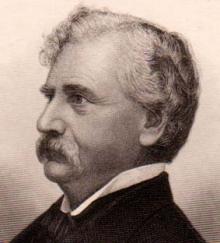- Home
- Archival Material
- College History Projects
- Subject-Based Digital Projects
George Purnell Fisher (1817-1899)

George Purnell Fisher was born in Milford, Delaware on October 13, 1817 to Thomas Fisher (twice high sheriff of Kent County) and his third wife Nancy Owens Fisher. He went to schools in the county, attended St. Mary's College in Baltimore, Maryland briefly in 1835 and then enrolled at Dickinson College with the class of 1838. A Methodist at the Methodist sponsored college, he was a member of the Belles Lettres Society before graduating with his class. Studying afterwards in the law, he joined the Dover law firm of John M. Clayton, a family friend, and combined his studies with tutoring the young Clayton children. He was called to the Delaware bar in April 1841 and began practice in Dover.
Fisher became involved very swiftly in state politics. He served as clerk of the state senate in 1843 and then was elected to the state house as representative for Kent County. Governor Joseph Maull, a Democrat, named him as secretary of state for Delaware on March 5, 1846 and Maull's successor, William Temple, reappointed him. His old mentor, John Clayton, became United States Secretary of State and took Fisher to Washington with him as his confidential clerk. This expanded his experience to diplomacy, aiding his chief in the framing of the Clayton-Bulwer Treaty, signed on April 19, 1850, that calmed Anglo-American tensions in central America that the idea of a trans-Nicaragua canal had raised. President Taylor also sent him to South America as a commissioner of claims in a dispute with Brazil between 1850 and 1852.
Fisher tended to impress those in authority who observed him - beyond his talents he was over six foot tall and had a military bearing. In July, 1850, when Zachary Taylor died suddenly, he served as temporary private secretary to the incoming Millard Fillmore, until the new president's son took up the permanent appointment. Following his time in Washington, the American Party Governor, Peter Foster Causey, appointed him in March 1855 to a five year term as the attorney general of Delaware. As the Civil War loomed, he was elected against the odds to the United States Congress as a Unionist in the pivotal 1860 election and served from 1861-1863. Meanwhile, he also helped organize the military effort in his state, being named as the colonel of the 1st Delaware Cavalry. In Washington, D.C., he had caught the eye of President Lincoln, who took him as a confidant and advisor concerning Delaware. Lincoln enlisted Fisher and his fellow Dickinsonian from the state, Nathaniel Smithers, in his plan for gradual and compensated emancipation of Delawware slaves in 1862. The plan - to free ten percent of slaves per year with compensation - saw bills written in both houses of the legislature but defeated as too cautious by members committed to abolition.
When Fisher was defeated as a Republican in the 1862 election, Lincoln appointed him as one of the four justices to the new Supreme Court of the District of Columbia. He was confirmed on March 11, 1863 and served in that post till May 1870. Ironically, his most famous case involved the trial of John Harrison Surratt, one of the accused assassins of his friend Abraham Lincoln. The trial opened on June 10, 1867 and ended in a hung jury and Surratt's release but Fisher won widespread praise for his conduct of a difficult trial. In May 1870, he left the bench when another president who had taken him as a confidant, Ulysses S. Grant, appointed him as the United States Attorney for the District of Columbia. He was in that post until 1875 when he returned to Delaware. Fisher returned to his last public service when President Benjamin Harrison named him on May 31, 1889 to a four year appointment as the first auditor of the United States Treasury. On March 23, 1893, the seventy-four year old Fisher returned at last to Delaware to resume private life in retirement.
Fisher married Eliza A. McColley of Milford in 1840 and the couple had two boys and two girls. George Purnell Fisher died after a short illness in Washington D.C. on February 10, 1899 and is buried in the Methodist Cemetery in Dover Delaware. He was eighty-one years old.
Date of Post:
2005
College Relationship:
Alumnus/Alumna Class Year: